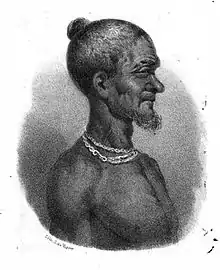Badu Bonsu II
Badu Bonsu II was a leader of the Ahanta and a Ghanaian king who was executed in 1838 by the Dutch, who, at the time, were in control of the Dutch Gold Coast.[1]

Rebellion against the Dutch
In 1837, Badu Bonsu II rebelled against the Dutch government, and killed several officers, including acting governor Hendrik Tonneboeijer. The Dutch government used the Treaty of Butre as the basis for military action against Badu Bonsu and an expeditionary force was sent to Ahanta. In the war that followed, the king was captured, sentenced for murder, and hanged. The Dutch disorganised the Ahanta state, appointing their commandant of Fort Batenstein at Butre as regent, keeping the country under close control with an enlarged military and civilian presence.[2] Following the execution of king Badu Bonsu, his body was desecrated as a Dutch surgeon removed his head. The head was taken to the Netherlands, where it was soon lost for more than a century.[3]
Rediscovery and return of the head
The head was rediscovered in the Leiden University Medical Center (LUMC) in the Netherlands by Dutch author Arthur Japin, who had read the account of the head during research for his 1997 novel De zwarte met het witte hart. Japin found the head in 2005, stored in formaldehyde at the LUMC.[4][5] In March 2009, government officials announced that it would be returned to its homeland for proper burial,[6][7] a promise fulfilled on July 23, 2009, after a ceremony held in The Hague.[8][9]
Citations
- "Badu Bonsu II; The King whose head was Preserved in a jar in a laboratory". Ghanaian Museum. 2020-01-20. Retrieved 2020-02-07.
- Doortmont & Smit 2007, p. 279, 282-283.
- "Badu Bonsu II; the King whose head was preserved in a jar in a laboratory". www.ghanaweb.com. Retrieved 2020-02-15.
- "Leiden geeft hoofd Badu Bonsu II terug". NRC Handelsblad. 21 March 2008.
- "Verhagen steunt terugkeer hoofd Ghanese koning". NRC Handelsblad. 22 December 2008.
- Clements, Joan (20 March 2009). "Netherlands to return king's head to Ghana". The Daily Telegraph.
- "Dutch to return Ghana king's head". BBC News. 20 March 2009.
- "Dutch return head of Ghana king". BBC News. 23 July 2009.
- "Bring us the head of King Badu Bonsu, said Ghana – and the Dutch". The Independent. 2009-07-25. Retrieved 2020-02-15.
References
- Doortmont, Michel R.; Smit, Jinna (2007). Sources for the mutual history of Ghana and the Netherlands. An annotated guide to the Dutch archives relating to Ghana and West Africa in the Nationaal Archief, 1593-1960s. Leiden: Brill. ISBN 978-90-04-15850-4.